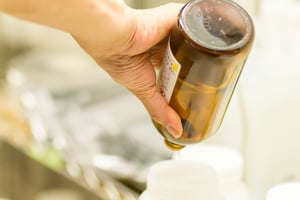Did you know that the water repellents used in outdoor clothing are changing now? Rain jackets that...
Non-fluorinated water repellent (= fluorine-free water repellent) rain jacket
Non-fluorinated water repellent clothing has become common in outdoor jackets over the past few years. In this article, we will explain what non-fluorinated water repellency is and how it differs from fluorinated water repellency. How are they different from fluorinated water repellent? And why has this trend developed? This article will explain the following.
What is non-fluorinated water repellency?
Non-fluorinated water repellents are water repellents that do not use the organo-fluorine compound PFAS.
There are several ways to refer to them: PFAS-free water repellent, PFC-free water repellent, and fluorine-free water repellent. These are used broadly to mean the same thing as non-fluorinated water repellents.
It is important to note that fluorine does not = organo-fluorine compounds. Organo-fluorine compounds are a part of fluorine, but not all fluorine is an organic compound.
In addition to organic fluorine compounds, there are inorganic fluorine compounds, and a familiar example of an inorganic fluorine compound is the fluoride in toothpaste.
Organic and inorganic compounds should not be equated just because they use the same fluorine. It is important to understand that they are totally different.
How is it different from fluorinated water repellent?
Fluorine has been useful in the past because it can provide very good water repellency. To explain a little more, when fluorine is included as a water repellent, it can create a bond between carbon and fluorine called a fluoroalkyl group.
At this time, the surface coated with this water repellent boasts high water repellent performance because it can provide a lower surface tension than the surface tension created by other elements.
Because fluorinated water repellent performance is, in principle, the highest performance among the water repellent performance that can be given by other elements, fluorinated water repellent agents have been used in applications where high water repellent performance is required.
Conversely, the use of non-fluorinated water repellents means that water repellent performance is reduced. For example, fluorinated water repellents can currently repel not only water but also oil.
However, non-fluorinated water repellents have difficulty repelling oil. This has resulted in a very weak resistance to stains. To compensate for this, manufacturers are now announcing the need for frequent washing.
Why the trend toward non-fluorinated products?
Why is there a shift to non-fluorinated products, even though their water-repellent performance is decreasing? This is due to the environmental issues and possible physical effects of the organic compound PFAS.
Organo-fluorine compounds have carbon-fluorine bonds that are so strong that they are very difficult to break down in the environment. They are spread around the globe by water and atmospheric flows, and PFAS are now found everywhere on the planet.
To begin with, the organo-fluorine compound PFAS does not exist in the natural environment, so a situation where PFAS is spread around in the environment, even though it is invisible, is not desirable. Therefore, a trend is taking place to avoid the use of PFAS.
The physical effects of PFAS have also influenced the trend toward non-fluoridation. It is important to note, however, that while we often see articles on the Internet stating definitively the physical effects of PFASs, it is only a possibility, and not all PFASs have been confirmed to be effective.
In recent years, the carcinogenic relevance of PFOA and PFOS, which are some of the PFAS substances, has become known. However, not all PFAS are PFOA or PFOS, and ingestion of PFOA or PFOS does not immediately cause cancer.
The amount and duration of intake must be taken into consideration, and there are some uncertainties in this area. However, as mentioned above, PFAS were created artificially in the first place and are not something that should be ingested, so the trend is toward eliminating PFAS.
Importance of restoring water repellency through non-fluorination
We believe that the shift to non-fluorinated is unavoidable due to the environmental aspects and possible physical effects, or rather, we believe that we have a responsibility to restore the environment after it has been degraded by human hands.
At this time, it is unfortunately inevitable that the water repellent performance will deteriorate. However, we need to promote non-fluorinated materials because environmental issues cannot be ignored because of poor performance.
For rain jackets made of high-functional materials, non-fluorination will result in poor water repellency, so work to restore water repellency is important to maintain high functionality.
At this time, there are methods of using waterproof sprays and water repellents available on the market, but for those who have tried these methods but have not been able to restore the water repellency as expected, we offer a professional water repellency restoration service.
If you have not been able to get your desired results, please contact us.



